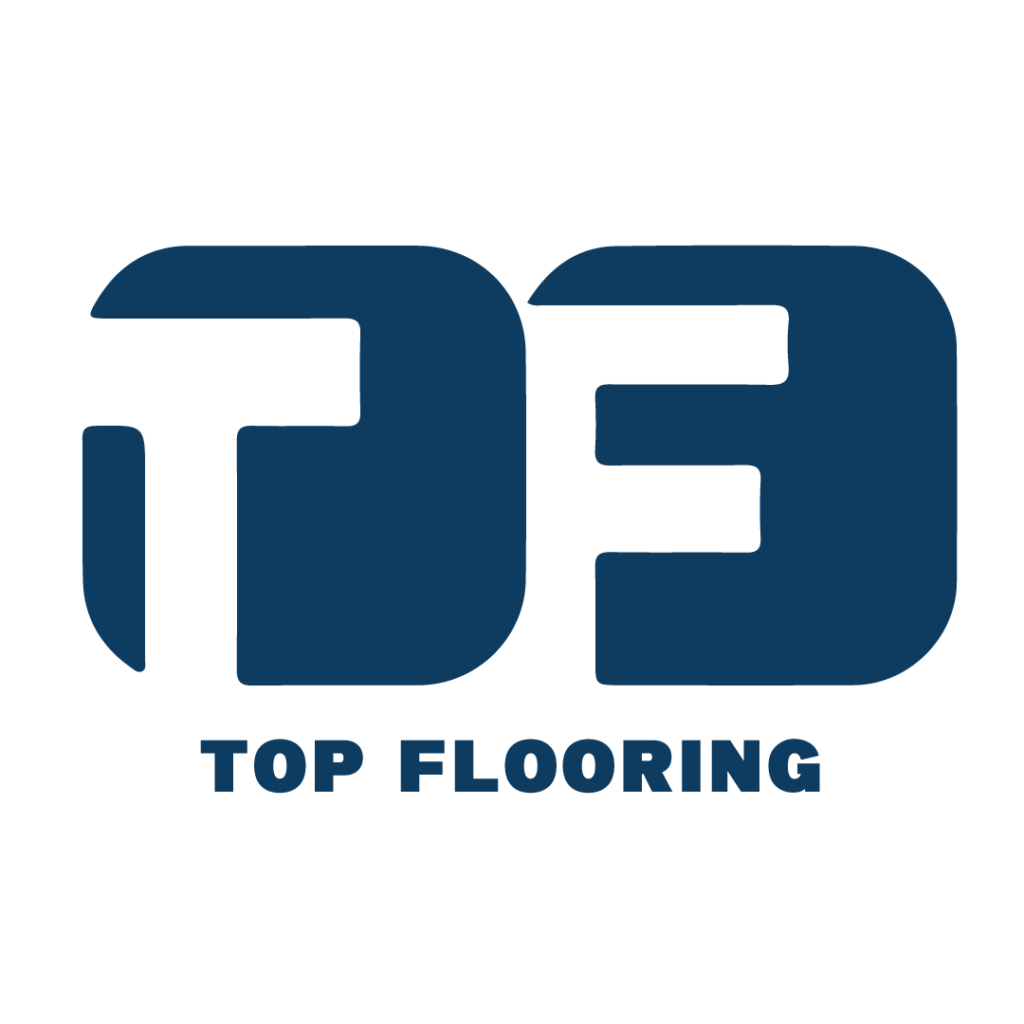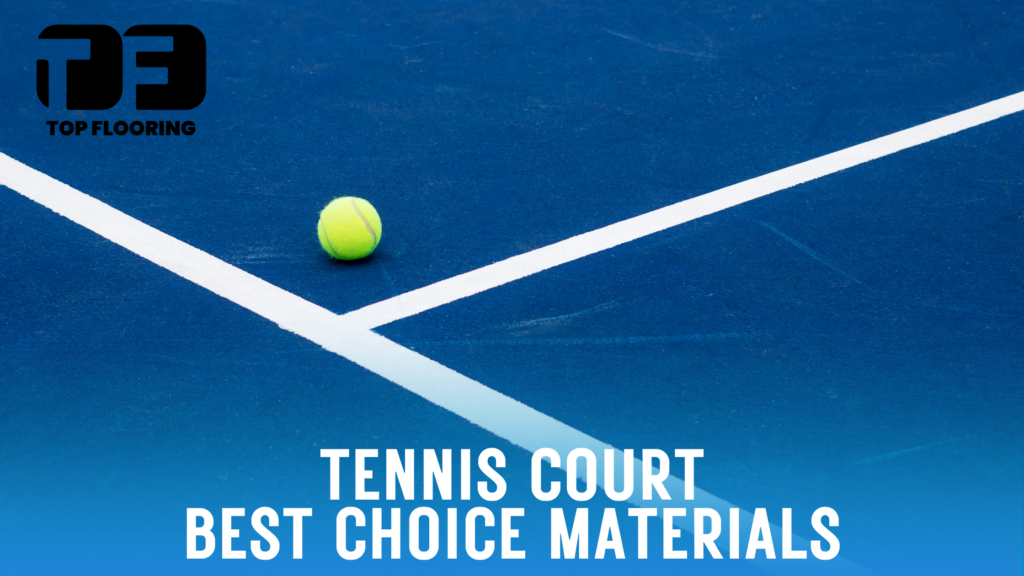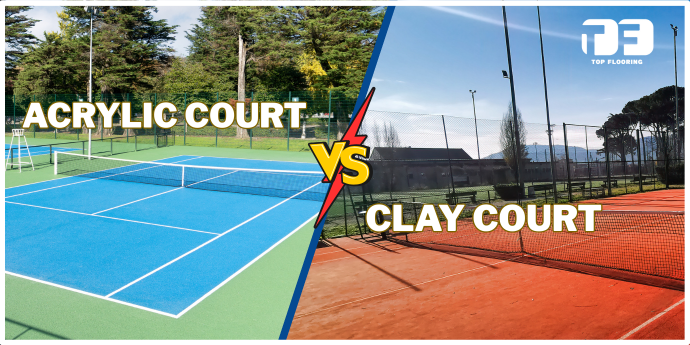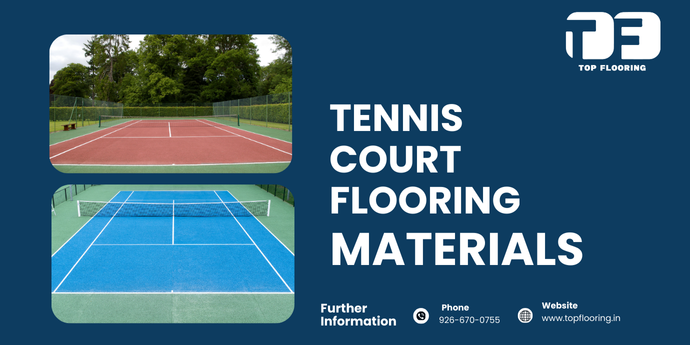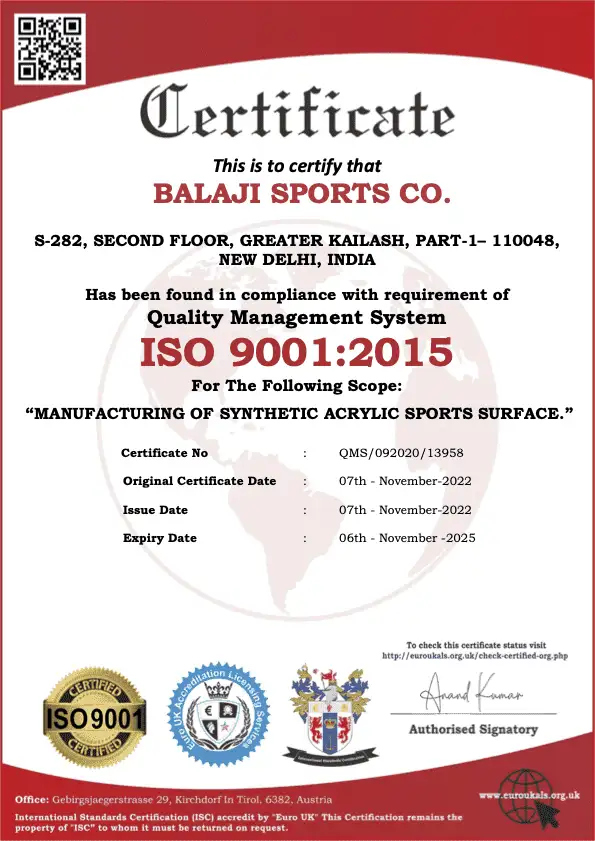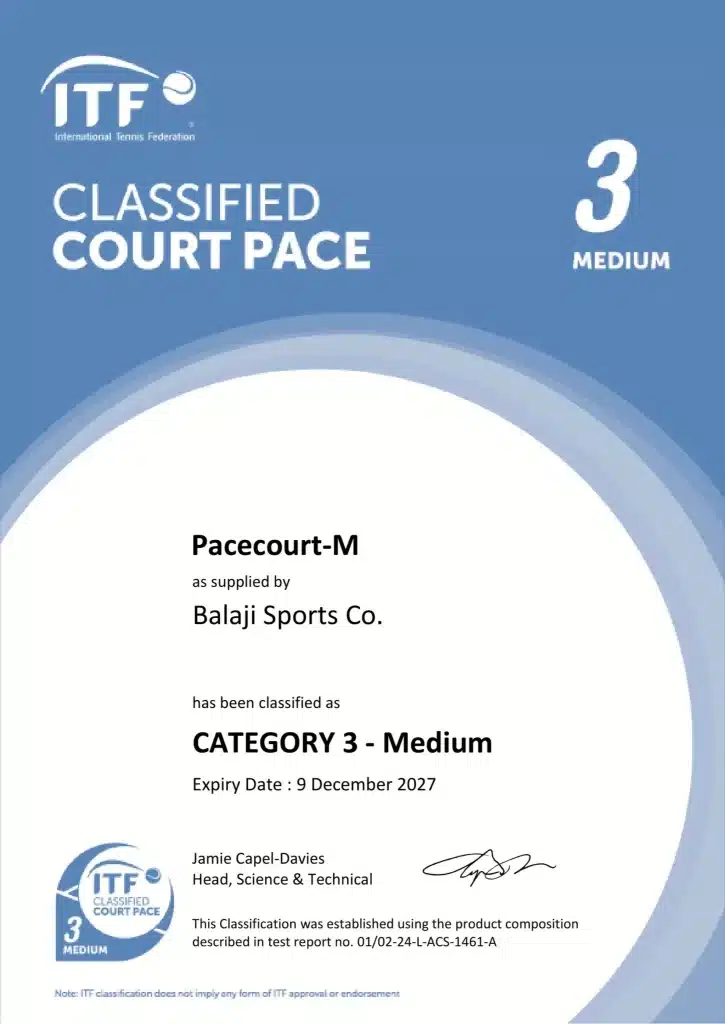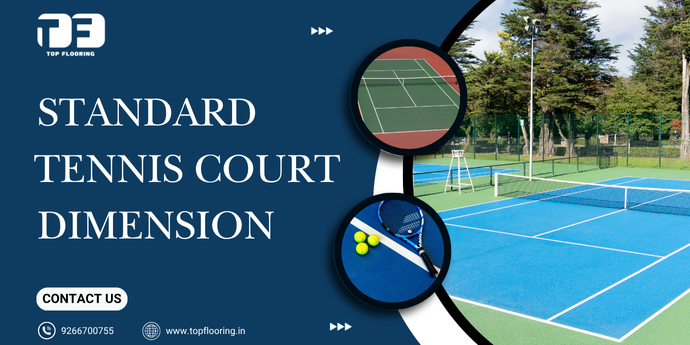
When thinking of a tennis court, also think of the sound of the ball, the intensity of the games, or the thrill of a winning shot. Rarely do we think of the exact length of the baseline or the width of the doubles alley. Without the right measurements, the game wouldn’t be tennis; it would be something else entirely. At Top Flooring, we don’t just supply synthetic acrylic material; we create outdoor tennis courts that hold the game together with excellence, consistency, and durability. Our courts are built on ITF-3 certified systems, so players know every bounce will respond as it should, no matter the weather or wear. With ISO-backed processes, we make sure every square foot of flooring meets international standards while being optimized for local conditions in India and abroad.
This isn’t just another article about tennis court dimensions. It’s a deep dive into why outdoor courts need precision, how certified materials impact gameplay, and what you need to know if you’re planning to build a tennis court that lasts for decades. Because in tennis dimensions are not just about space; they’re about fairness, performance, and trust. And at Top Flooring we make sure you get all three.
Standard Dimensions of an Outdoor Tennis Court
A tennis court may look like a simple rectangle to the viewers but every foot, inch and line matters. At Top Flooring, design courts that not only meet official standards but are optimized for outdoor play with synthetic acrylic hard surfaces making sure consistent performance, player safety, and durability.
Overall Length & Width
A standard outdoor tennis court follows exact measurements:
| Court Type | Length | Width | Area |
| Singles | 78 ft (23.77 m) | 27 ft (8.23 m) | 2,106 sq. ft (195.6 m²) |
| Doubles | 78 ft (23.77 m) | 36 ft (10.97 m) | 2,808 sq. ft (260.9 m²) |
Check how the tennis court length remains the same for singles and doubles. The only difference is in the width of the tennis court. These dimensions are carefully maintained on Top Flooring outdoor courts, which allows every player to experience the same bounce, whether in a casual game or competitive match.
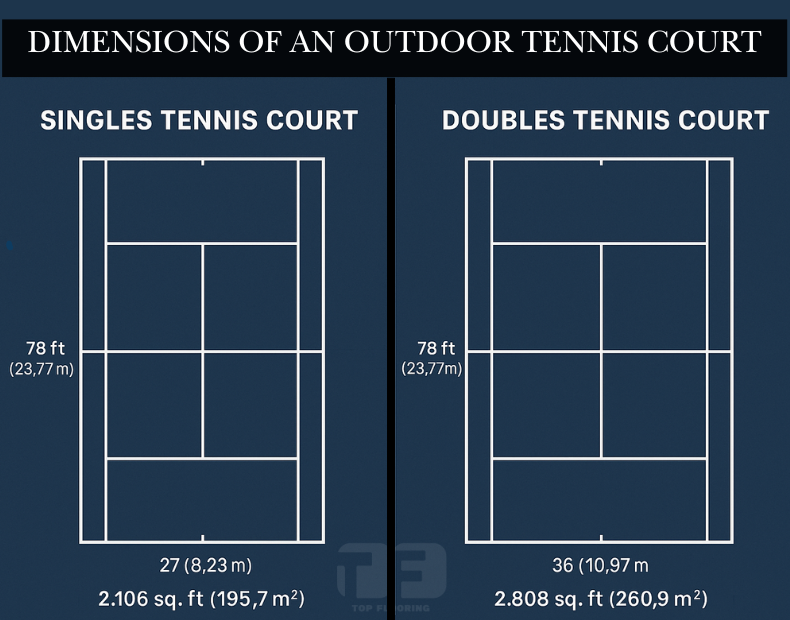
Tennis Playing Area vs Court Area
The playing area is just the tennis court lines, but a functional outdoor tennis court needs extra space around the tennis court for safety and comfort, often called run-off space.
- Minimum clearance behind baselines: 18–21 ft
- Minimum clearance on sides: 12–15 ft
Adding this extra space, a full single or double tennis court takes up
- Singles court: ~7,200–7,500 sq. ft
- Doubles court: ~7,800–8,100 sq. ft
Top Flooring calculates these areas to make sure players have enough room to move while the tennis court fits in the available land.
Key Tennis Court Components
Every part of the court has a purpose:
- Service Boxes
- Each side of the net has 2 service boxes that are 21 ft × 13.5 ft
- Correct dimensions make sure exact serve placement and fairness during games.
- Net
- Standard net length: 36 ft
- Net height at center: 3 ft, at posts: 3.5 ft
- The synthetic acrylic system has the net posts perfectly aligned, and the net tension is perfect for outdoor conditions.
- Baseline & Sidelines
- Baselines run side by side to the net at the back of the tennis court; sidelines mark the width of the tennis court.
- Singles play: sidelines are 27 ft apart
- Doubles play: sidelines are 36 ft apart
- Doubles Alley
- The area between the singles and doubles sidelines is 4.5 ft wide on each side.
- This space is for doubles play, so extra players can fit without affecting the tennis court balance.
Why Do Standard Dimensions Matter on Outdoor Hard Tennis Courts?
A tennis court is more than lines on a surface; it’s the stage where every game, serve, and volley happens. When it comes to outdoor hard tennis courts like the synthetic acrylic courts Top Flooring specializes in precision in dimensions matters. Even a small crack can affect bounce, player movement and overall play.
1. Fair Play & Consistent Bounce
The most obvious reason for standard tennis court dimensions is fairness. ITF approved measurements mean every singles or doubles match is played under the same conditions. On a Top Flooring synthetic acrylic outdoor tennis court every square inch is designed to deliver consistent ball bounce regardless of weather. This is important for competitive matches, training sessions and recreational play. Players can rely on dullness not an uneven surface to decide the outcome.
2. Player Safety First
Safety is often overlooked but it’s one of the most important reasons for standard court dimensions. Enough run off space behind baselines and along sidelines means players can chase the ball without colliding with fences or obstacles. On hard tennis courts especially proper spacing reduces the risk of slips, falls and joint strain. Top Flooring designs outdoor tennis courts with player safety in mind combining exact dimensions with high quality synthetic acrylic tennis court flooring that provides the right balance of grip and shock absorption.
3. Tournament Ready & Professional Standards
For clubs, academies and private facilities a tennis court that doesn’t meet ITF certification standards can’t host professional or semi professional tournaments. Top Flooring makes sure every outdoor hard tennis court we build meets ITF-3 certification so the court is suitable for official matches. This includes accurate line markings, correct net height and exact playing area dimensions. Choosing a certified tennis court isn’t just about compliance, it’s about delivering a professional playing experience every time.
Why Top Flooring Stands Out?
Many companies build courts that look right, but appearance alone doesn’t make a tennis court playable. Top Flooring focuses on performance driven construction, ISO certified processes and ITF approved standards. From the service boxes to the doubles alleys every detail is engineered to improve play, protect players and meet international standards.
When you buy a Top Flooring outdoor tennis court you’re not just buying a surface you’re getting a court that performs, lasts and meets professional standards, all in an outdoor environment that’s exposed to sun, rain and temperature changes.
ITF Certification & Outdoor Courts
Not all outdoor tennis courts are created equal. A court may look professional but without ITF certification the speed, bounce and performance can be uneven. Top Flooring specialize in ITF certified synthetic acrylic hard tennis courts, so every outdoor court delivers a consistent tournament-ready experience.
Understanding ITF Court Categories
The International Tennis Federation (ITF) categorizes tennis courts into 5 categories based on surface speed, known as pace ratings:
| ITF Category | Pace Rating | Description |
1 | Slow | Maximum control, often on clay courts. |
2 | Medium-slow | Faster than slow courts; recreational play. |
3 | Medium | Balanced speed and bounce; most outdoor hard courts. |
4 | Medium-fast | Faster courts; quick reflexes required. |
5 | Fast | Maximum ball speed; elite tournaments. |
Top Flooring outdoor courts are built to ITF-3 standards, offering a medium pace that balances playability, player safety, and versatility. This makes ITF-3 certified tennis courts perfect for schools, academies, clubs, and private facilities where players of all levels need a predictable, professional-quality surface.
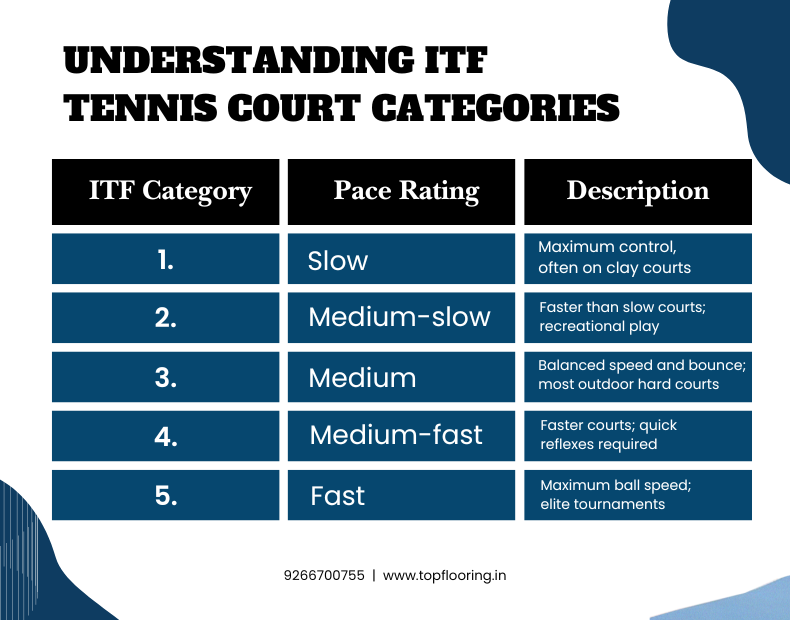
Why ITF-3 Matters?
Choosing an ITF-certified court means:
- Bounce is the same across the whole tennis court.
- Speed is standardised so players can develop and fine tune your skills.
- Tournaments and matches can be held so the tennis court is suitable for competition.
Many tennis court builders build courts without explaining the certification relevance. At Top Flooring we educate our clients on why ITF-3 is the best choice for outdoor acrylic hard tennis courts it’s not just a label; it’s a guarantee of performance, durability and international standards.
How Top Flooring Meets ITF Standards?
Our synthetic acrylic flooring system is designed to meet and exceed ITF specifications:
- Precise thickness & layering for uniform ball bounce.
- Acrylic coating & texture for controlled speed and grip for outdoor conditions.
- Durable materials that withstand sun, rain and temperature variations without compromising performance.
- ISO certified processes for consistent quality across every tennis court we build.
With Top Flooring an ITF-3 certified outdoor tennis court is not just a promise it’s a measurable, playable and long lasting reality. Players experience true bounce, professional grade pace and safety so every match feels like it’s on a tournament standard court.
Outdoor Tennis Court Layout
A tennis court is more than a base with a net. The layout affects gameplay, player safety and match fairness. Top Flooring specialize in exact engineered outdoor hard courts, every line, box and zone is placed according to ITF standards and optimized for synthetic acrylic surfaces.
1. Line Markings
Line marking is the backbone of any tennis court. Here’s a breakdown:
- Baseline:
- At the back of the tennis court, side by side to the net.
- Marks the primary boundary for games.
- Sidelines:
Defines the court’s width:
- Singles play: 27 ft
- Doubles play: 36 ft
- Center Service Line & Service Boxes:
- The tennis court is split into left and right service boxes by the center service line.
- Each box is 21 ft × 13.5 ft
- Exact positioning makes sure accurate serve placement and fair scoring.
- Doubles Alley:
- The area between singles and doubles sidelines is 4.5 ft wide.
- Provides extra space for doubles games without compromising singles gameplay.
On every Top Flooring court, these lines are laid exactly. This is important for competitive play, player safety and ITF regulations.
2. Color Coat & Acrylic Coating
A synthetic acrylic tennis court is more than just a painted surface it’s engineered for performance:
- Playing Area:
- Typically coated with a medium-textured acrylic layer.
- Make sure consistent ball bounce and player grip.
- Outer Zone:
- Lighter or contrasting color to visually separate the playing area.
- Provides cues for foot placement and movement during high-speed games.
- Acrylic Layering:
- Multiple layers are applied to achieve uniform thickness.
- Top Flooring uses ISO-certified acrylic systems designed to withstand sun, rain and heavy usage while maintaining ITF-approved speed and bounce.
3. Why Precision Matters in Outdoor Installations
Precision in layout is not just a technical requirement it affects:
- Gameplay: Miscalculated lines affect ball bounce and court speed.
- Safety: Misplaced service boxes or alleys increase tripping and collision risk.
- Certification: Only measured tennis courts are ITF-3 certified.
Every Top Flooring outdoor tennis court is measured by laser and built with precision, the synthetic acrylic surface, lines and color zones meet professional standards. So you get a uniform, durable and tournament ready court from day one.
Extra Space Around the Court (Outdoor Specifics)
A tennis court’s dimensions don’t stop at the baseline or sidelines. Especially for outdoor tennis courts, the surrounding space is just as important as the playing surface itself. Top Flooring design courts with safety, performance, and longevity in mind, making sure players have enough room to move freely while protecting the tennis court from environmental factors.
1. Recommended Clearance
For outdoor hard courts, ITF and professional guidelines suggest:
- Behind baselines: 18–21 ft
- Along sidelines: 12 ft
This extra space, known as run-off or safety clearance, allows players to chase balls without risking collisions with fences, walls, or obstacles. On Top Flooring courts, these measurements are carefully combined during planning to maximize safety and comfort without compromising land use.
2. Why Outdoor Courts Need Extra Safety Space
Unlike indoor courts, outdoor courts face several challenges:
- Wind & Weather: Outdoor tennis court conditions can push the ball beyond the playing area. Extra space makes sure games aren’t interrupted and players can safely retrieve balls.
- Ball Chase & Movement: Tennis is dynamic; players often sprint, slide, or dive for balls. Proper clearance stops injuries.
- Fencing & Surrounding Infrastructure: Fences, seating areas, and pathways are standard around outdoor tennis courts. Enough clearance makes sure they don’t interfere with play while keeping balls contained.
Top Flooring carefully balances these factors, providing enough room for unrestricted gameplay while maintaining professional aesthetics.
3. Fencing, Lighting Poles, and Drainage
Outdoor tennis courts require more than just space they need functional infrastructure:
- Fencing: Properly positioned to contain balls, stop unauthorized entry, and protect surroundings. Typically 10–12 ft high around the perimeter.
- Lighting Poles: Outdoor lighting is important for evening play. Clearance around poles is calculated so they don’t obstruct the tennis court or create shadows that affect visibility.
- Drainage: Hard courts must drain efficiently to avoid water pooling, which can damage acrylic surfaces and affect ball bounce. Top Flooring incorporates slight slope designs and high-quality drainage systems to maintain durability and playability in all weather conditions.
By considering all these elements, Top Flooring outdoor tennis courts provide a complete solution that goes beyond just the playing surface. Every detail from run-off space to fencing and drainage is carefully planned to make sure safety, performance, and long-lasting quality.
Mistakes People Make in Outdoor Court Dimensions
Building an outdoor tennis court seems simple, but small mistakes can affect performance, safety and longevity. Many DIY or low-cost installations miss the details, resulting in tennis courts that look good but fail in real play. Top Flooring makes sure every tennis court is ITF-certified, dimensionally accurate and built for outdoor use.
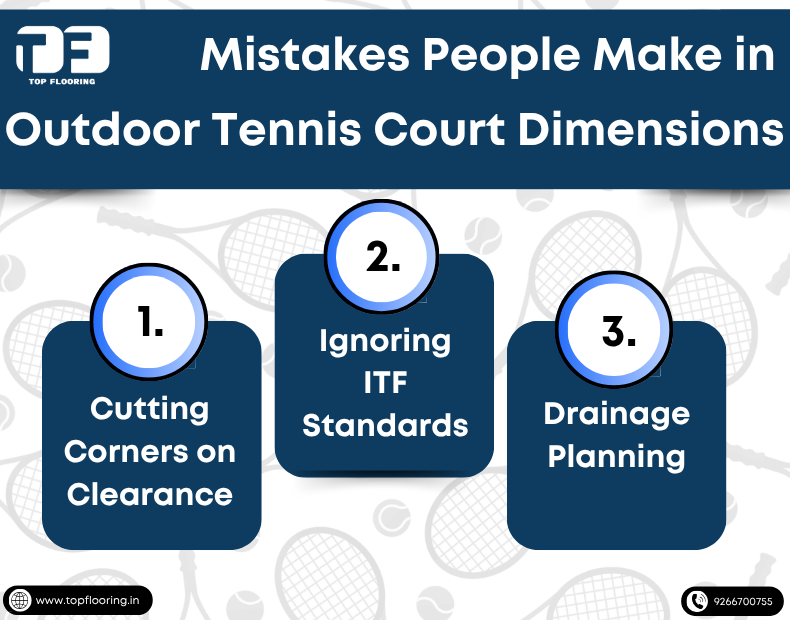
1. Cutting Corners on Clearance
One of the biggest mistakes is underestimating run-off space behind baselines and along sidelines. Skipping clearance may save land initially but creates safety risk:
- Players have less room to chase balls, increasing risk of slips, collisions or falls.
- Fencing or obstacles may interfere with play, causing frustration and injuries.
2. Ignoring ITF Standards
Some installations focus on looks and ignore ITF-approved tennis court size and speed ratings. Consequences are:
- Inconsistent ball bounce, affecting training and play
- Tennis courts can’t host official matches
- Reduced resale or usage value for schools, academies and clubs
3. Drainage Planning
Outdoor tennis courts are exposed to sun, rain and temperature changes. Poor slope or drainage planning can:
- Cause water pooling, damaging acrylic layers and affecting ball bounce
- Faster wear and tear of the tennis court surface
- Make the tennis court unsafe or unplayable after rain
Why Expertise Matters?
Many outdoor tennis courts fail not because of the surface material or lines, but due to planning mistakes that affect dimensions, drainage, and safety. Top Flooring team uses ITF-verified tennis court construction methods to correct these mistakes before they happen, delivering outdoor tennis courts that are safe, durable, and professional-grade.
Conclusion
Constructing an outdoor tennis court is about more than just lines on the ground. Correct ITF-approved tennis court measurement, proper clearance, and exact layout are important for player safety, consistent gameplay, and long-term durability. Combined with a high-quality synthetic acrylic tennis court surface, these elements make sure every court delivers professional-level performance, whether for schools, academies, clubs, or private facilities.
Top Flooring specialize in ISO-certified, ITF-3 approved outdoor acrylic hard courts. Our expert team designs and installs courts that meet international standards, are weatherproof, slip-resistant, and built to last, and provide an optimal playing experience for athletes of all levels.
Ready to build your next outdoor tennis court? Contact Top Flooring today to plan a tournament-ready, professional-grade synthetic acrylic court tailored to your space, budget, and requirements.
Frequently Asked Questions
An outdoor tennis court including the run off area is around 120 ft × 60 ft to meet ITF-3 standards and allow for safe player movement.
Yes. A compact or mini-tennis court can be built in smaller areas by reducing the outer safety zones while keeping the 78 ft × 27 ft (singles) or 78 ft × 36 ft (doubles) play area intact.
The ITF approves court size of 78 ft long and 36 ft wide for doubles, and 27 ft wide for singles.
At least 21 ft behind each baseline and 12 ft along each sideline is recommended, so players have room to move safely without hitting fences or walls.
Acrylic has UV resistance, slip control, and all-weather durability so you get consistent ball bounce, minimal maintenance and long term performance for outdoor tennis courts.
